Transition From Hardware- to Software-Centric Development
As Mr. Kataoka, General Manager of Automotive Solution Business Unit, said in his recent blog article, "Overview of Renesas Automotive Business Strategy,” the value of today’s vehicles is shifting from traditional vehicle hardware that controls driving, turning, and stopping, to the four megatrends of C.A.S.E. (Connected, Autonomous, Shared & Service, and Electrified). This means that the value of vehicles is now being created by integrating technologies and services other than hardware, such as software, cloud connectivity, to provide an unprecedented user experience (UX). There is no doubt that the trend in the automotive industry is moving toward a software-centric era in which the value of a vehicle is defined by software.
This change in vehicles is also extending the value of vehicles. Major model changes occur every few years. Traditionally, once a vehicle was launched, no new features were added during its life cycle. As a result, if owners wanted to add new features or value to their vehicles, they had to switch to a new vehicle with the features they wanted. However, in the future, software-centric vehicles will always have access to the latest features and UX, just as with smartphones, without having to replace with a new vehicle.
Software First and Shift Left
In the conventional hardware-centric development method, it’s difficult to adapt to these changing megatrends and deliver vehicles quickly to market. In order to extend the value of vehicles by continually updating with new features, we must change our method to develop vehicles based on a software-driven approach, often called "Software First" and "Shift Left.”
It is important to understand that Software First does not simply mean creating software first. The Software-First approach is to define product specifications for new applications and services first by considering what to create and what new experiences and value to provide to users before thinking about specific hardware configurations and mechanisms. This Software-First approach allows us to create new solutions that are not limited by hardware (mechanical components and E/E systems) that makes up the system.
On the other hand, “Shift Left” means that developers should adopt processes that determine the features, differentiating factors, and quality of the product as early in the development cycle as possible. For example, developers used to verify the system performance with actual hardware, but today, they are able to use a virtual environment such as simulators to evaluate before the hardware is available.
Virtual environments can greatly improve the limitations of hardware, such as prototypes and measurement environments, thus providing a comprehensive evaluation method that could not be done with hardware. This improved method makes the output of each process more accurate and reduces losses due to rework. By pursuing this “Shift Left,” product development time can be significantly reduced.
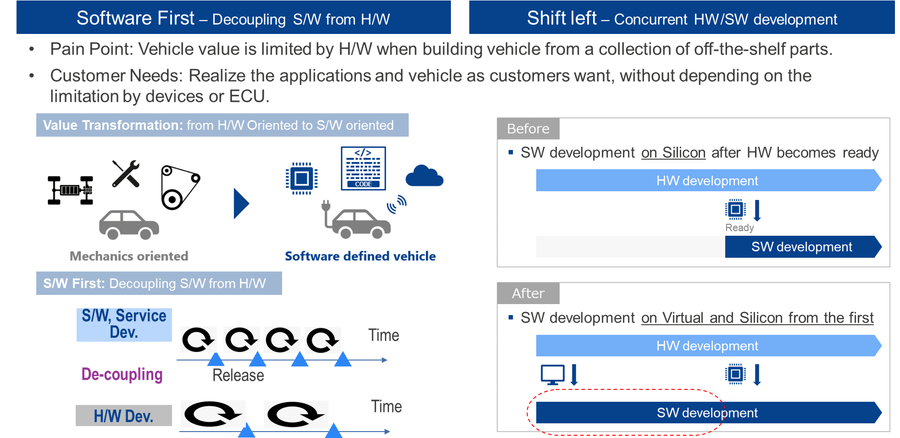
Renesas' Integrated Virtual Development Environment and DevOps Solutions
In response to this shift in automotive system development, we have started providing a new Integrated Virtual Development Environment in 2022 to achieve Software First and Shift Left for our Tier-1 customers, automotive manufacturers and in-vehicle ECU developers. We, Renesas, provide not only SoCs and MCUs, but also a variety of semiconductor products necessary to build E/E systems for vehicles, such as sensors, power control, and motor control.
In order to provide customers with the benefits of our comprehensive product line, we must be able to offer software and design environments that support development of ECUs and E/E systems for the entire vehicle, in addition to development tools for single devices as in the past.
This integrated virtual development environment provides software and design environments for building products with our scalable devices under a single environment, regardless of device types or application types (AD/ADAS, automotive gateway, etc.). This allows customers to develop system-level applications optimized for their objectives at an early stage before hardware (devices, PCBs, ECUs) becomes available.
We are also working to build a DevOps (Development and Operations) environment, which is an ideal solution to achieve the Software First and Shift Left concepts. This DevOps solution consists of a virtual environment on the cloud and a real environment on the edge such as the customers’ development sites or end-users’ vehicles. The basic concept of this DevOps solution is to reproduce the usage of devices, software, and development environment in the real environment on the edge in a virtual development environment on the cloud. This will allow us to identify customer needs for improvements and new functions, and develop the next solution or product for customers as quickly as possible.
Building the virtual development environment on the cloud is an important first step toward realizing this DevOps solution.
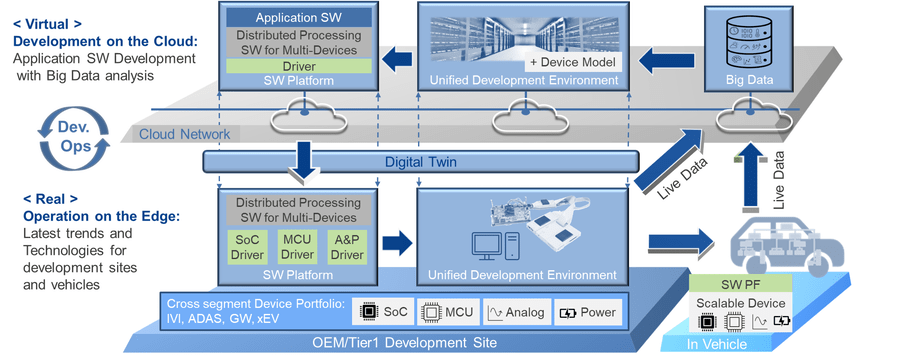
Multi-Devices Software and Virtual Development Environment for System Development
To realize the integrated virtual development environment and DevOps solution, Renesas has announced several solutions in 2022. One of these solutions is the "Integrated Development Environment that Enables ECU-Level Automotive Software Development without Hardware," which we announced in September 2022.
The key to achieving this system-level integrated virtual development environment is "multi-devices.” In the conventional E/E architecture, ECUs are prepared for each application, such as motor control and engine control, and are distributed throughout the entire vehicle. However, centralized and zone architectures are expected to become the mainstream design of E/E architectures in the future. These future architectures require ECUs that control domains and zones to execute very complex and sophisticated processing. Therefore, multiple SoCs and MCUs will be integrated into a single ECU.
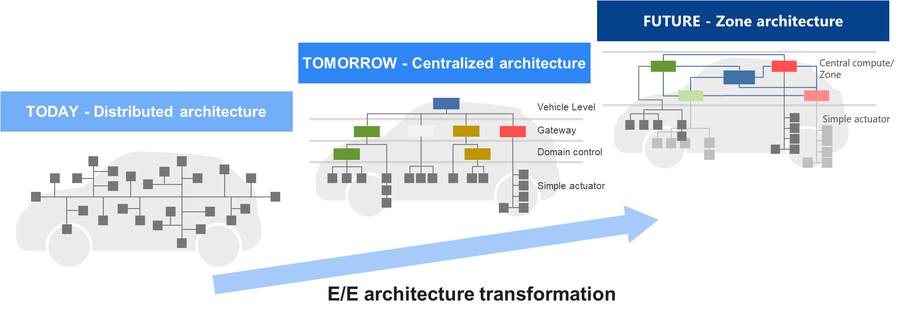
To support the development of ECUs with such multi-device configurations, Renesas has started providing "Multi-Device Co-Simulation Environment" and "Distributed Processing Software for Multi-Devices" in 2022. This allows developers to simulate the cooperative behavior of multiple devices, so that application functions can be divided among multiple devices and the necessary functions can be optimally allocated to CPUs and hardware IP in the devices to maximize hardware performance.
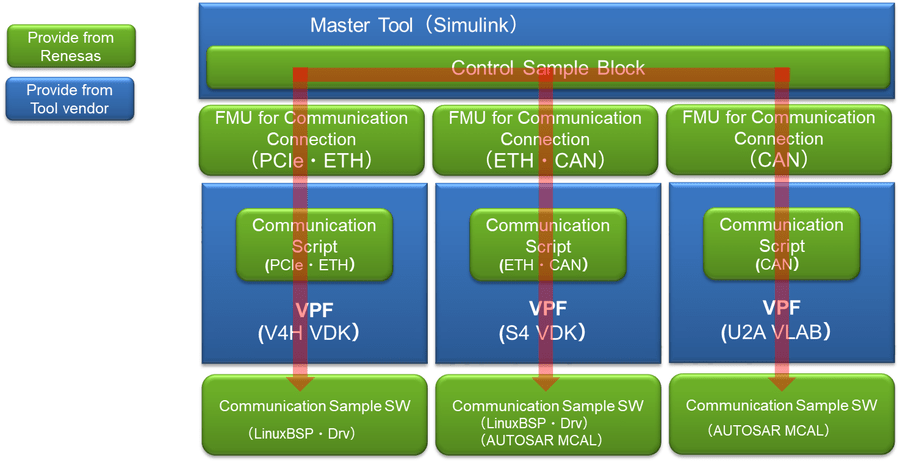
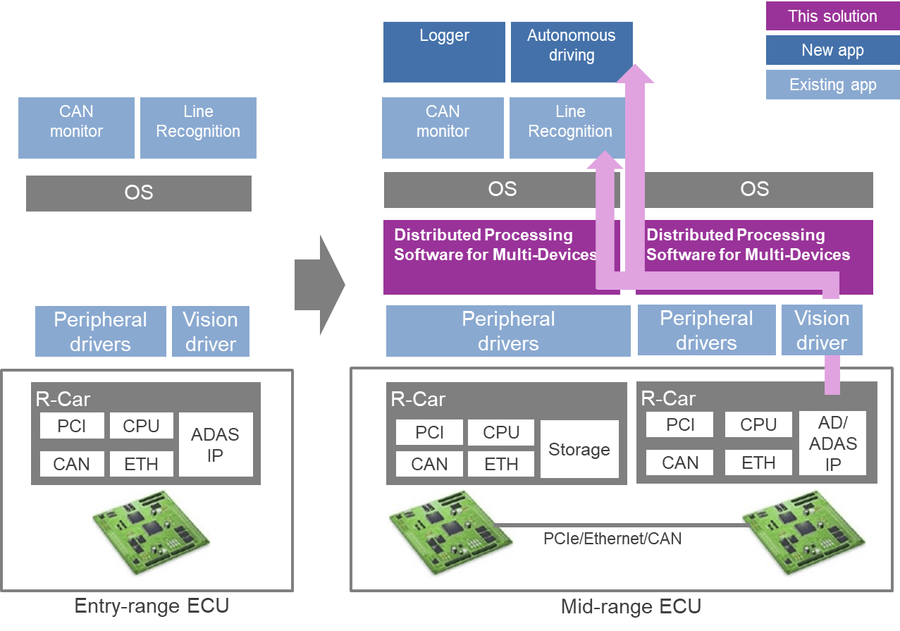
AI Development Environment on the Cloud
We have started providing a development environment on the cloud as a first step to realize the DevOps solution. This is the "GENESIS for R-Car Cloud-Based Evaluation Environment" which was developed jointly with Fixstars in March 2022.
With GENESIS for R-Car, users can easily check the AI processing performance of Renesas’ R-Car V3H using various CNN network algorithms without preparing dedicated hardware such as evaluation boards or development environments. Furthermore, users can also remotely operate and evaluate the actual device connected to the server on the cloud.
For AI development, in collaboration with Fixstars, we have also started providing a set of Tools to Optimize AI Software for AD/ADAS on R-Car SoC in December 2022. These tools optimize the network models used in AI processing for the R-Car hardware. In addition, we support our customers' application development at the system level by providing high-speed simulation environments for AI processing software.
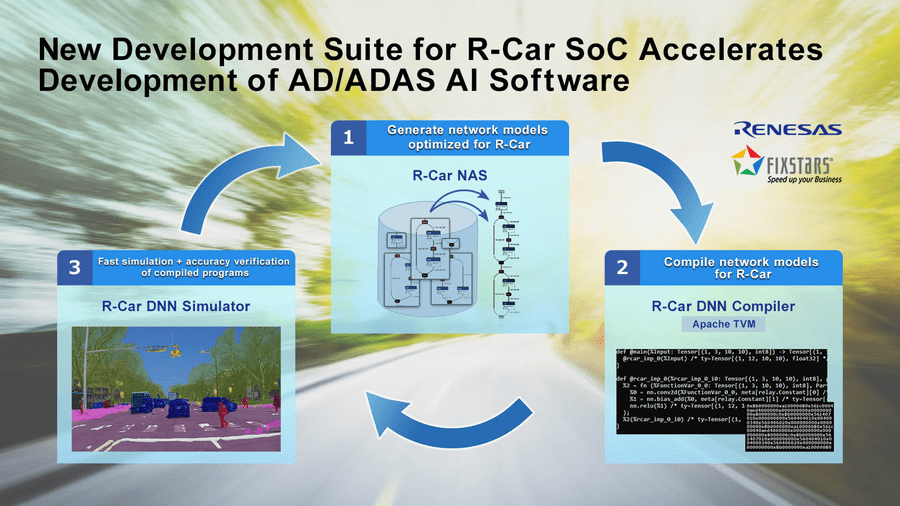
Conclusion
The software and virtual development environments introduced here are the first steps toward our goal of creating an integrated virtual development environment at the system level. This year, we plan to release a series of new products that will expand our solutions offerings. We will continue to introduce new products through PR announcements and blogs, so please look forward to the continued evolution of Renesas' integrated virtual development environment.
For more information on the individual software and development environments mentioned in this blog, please visit the following pages.
Products:
- Integrated Development Environment that Enables ECU-Level Automotive Software Development without Hardware
- "GENESIS for R-Car" Cloud Evaluation Environment for R-Car
- Tools to Optimize AI Software for AD/ADAS on R-Car SoC
Blog:
